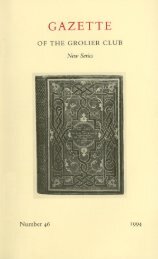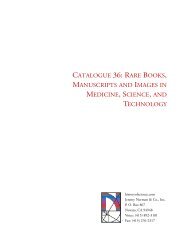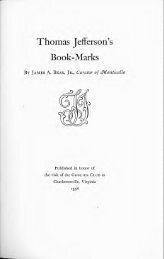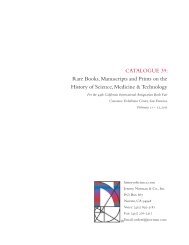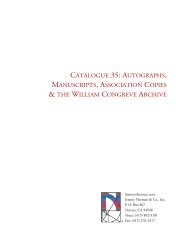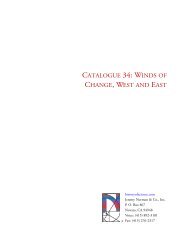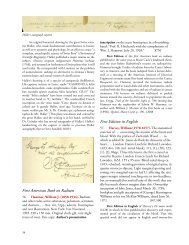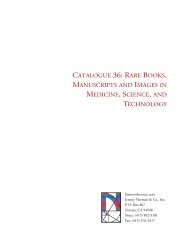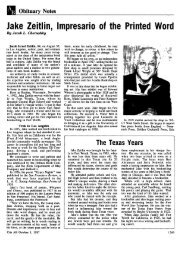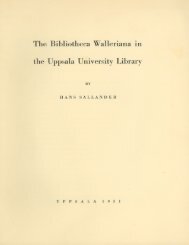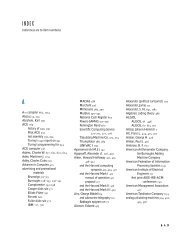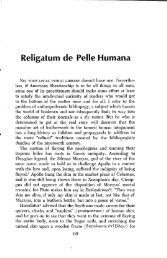Catalogue 38, Part 3 - Jeremy Norman's HistoryofScience.com
Catalogue 38, Part 3 - Jeremy Norman's HistoryofScience.com
Catalogue 38, Part 3 - Jeremy Norman's HistoryofScience.com
You also want an ePaper? Increase the reach of your titles
YUMPU automatically turns print PDFs into web optimized ePapers that Google loves.
Newton’s emission theory, according to which light<br />
consists of particles. On this picture the scattering of<br />
light by the sun be<strong>com</strong>es an exercise in Newtonian<br />
scattering theory. . . . Soldner made the scattering calculation,<br />
put in numbers, and found ? [the value of the<br />
deflection]= 0.”84” (Pais, p. 200)—a result remarkably<br />
close to the actual value of 0.”87. In 1911 Einstein, in<br />
his paper “Ueber den Einfluss der Schwerkraft auf die<br />
Ausbreitung des Lichtes” (Ann. Phys. 35: 898-908),<br />
used a different method but the same basic assumptions<br />
to <strong>com</strong>e up with a similar value for this “Newtonian<br />
deflection.” The gravitational bending of light by<br />
the sun was one of three tests Einstein posed in 1916 to<br />
confirm the general theory of relativity; in 1919, Sir<br />
Arthur Eddington and his collaborators became the<br />
first to observe and record this phenomenon. Pais, Subtle<br />
is the Lord, pp. 198-200. 40861<br />
Stern-Gerlach Experiment<br />
97. Stern, Otto (1888-1969) et al. (1) Ein Weg<br />
zur experimentellen Prüfung der Richtungsquantelung<br />
im Magnetfeld. In Zeitschr. f. Physik 7<br />
(1921): 249-253. (2) (with Walter Gerlach<br />
[1889-1979]). Der experimentelle Nachweis des<br />
magnetischen Moments des Silberatoms. In ibid. 8<br />
(1921): 110-111. Together 2 whole volumes. [iii]-<br />
vi, 414; iv, 419pp. Braunschweig: Fried. Vieweg<br />
& Sohn; Berlin: Julius Springer, 1921-22. 224 x<br />
149 mm. Vol. 7 in half morocco, cloth boards, a<br />
little rubbed; Vol. 8 in half cloth, marbled boards.<br />
Library stamps on titles. $950<br />
First Editions. Stern, whom Emilio Segrè considered<br />
“one of the major physicists of the century” (p.<br />
1<strong>38</strong>), developed Dunoyer’s molecular beam method<br />
and used it to devise what is now known as the Stern-<br />
Gerlach experiment, which demonstrates the reality of<br />
space-quantization of atoms. This experiment had an<br />
enormous impact on modern physics, and has be<strong>com</strong>e<br />
a paradigm of quantum measurement.<br />
Spatial quantization had been introduced as a theoretical<br />
concept by Sommerfeld in 1916, but no one before<br />
Stern had ever demonstrated its existence, and some<br />
quantum physicists even considered it to be nothing<br />
more than a mathematical tool. In his 1921 paper,<br />
Stern proposed an empirical test: “If an electron in an<br />
atom carried a magnetic moment of about 1 Bohr magneton<br />
(= eh/4πm e ), an atomic beam of silver atoms<br />
should split in passing through a magnetic field of<br />
strong inhomogeneity” (Twentieth Century Physics, p.<br />
164). In the 1922 paper, written jointly with Walther<br />
Gerlach, Stern described the initial results of their<br />
experimental work. In three later papers (not included<br />
here) Stern and Gerlach continued their investigations,<br />
which provided direct experimental proof of directional<br />
[space-] quantization in a magnetic field. 40522<br />
Portrait of Mineralogist to Queen<br />
Victoria<br />
98. Tennant, James (1808-81). Photograph<br />
portrait by Maull & Polyblank. Albumin print<br />
mounted on paper, subject identified beneath the<br />
photograph in a 19th century hand. [London,<br />
86



